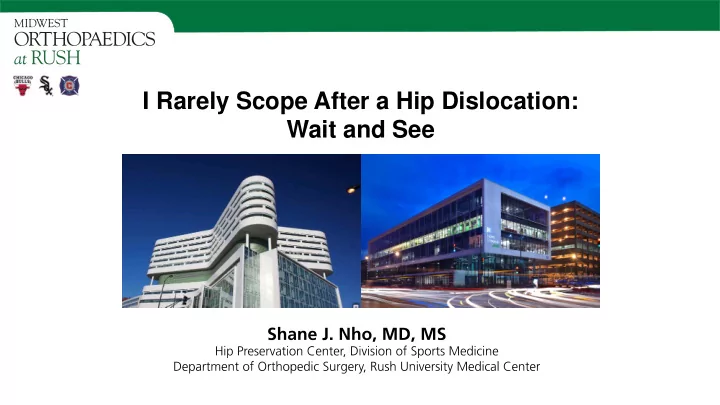

I Rarely Scope After a Hip Dislocation: Wait and See
I (and/or my co-authors) have something to disclose. Detailed disclosure information is available via: Printed Final Agenda AAOS Orthopaedic Disclosure Program on the AAOS website at http://www.aaos.org/disclosure
Case Example • 18 year old male playing football who sustained a right hip injury four days ago. • The patient states that he was running to catch passes diving on to the ground and somebody stepped on his heel as he was diving to catch the pass.
Plain Radiographs
Plain Radiographs
MRI
MRI
Follow Up • After PWB for 6-8 weeks, he underwent 4 phase PT program • Repeat MRI showed no evidence of AVN • He was able to return to football after 4 months
Management of Acute Hip Dislocations History and physical exam • Hip fixed in flexion, adduction, internal rotation • Neurovascular exam Radiographs: AP & lateral views & Judet views Acute management: closed reduction < 6 hrs • AVN 1-17% • CT scan after reduction • Controversial: indication for acute arthroscopy with retained fragment
Hip Instability Traumatic hip subluxations • MRI • Moorman et al. (JBJS 2003) traumatic posterior hip subluxation have triad of posterior acetabular lip fracture, iliofemoral ligament disruption, and hemarthrosis • Fluoroscopic aspiration to decrease intracapsular pressure • PWB for 6 wks • Repeat MRI to determine presence of AV
Traumatic Hip Instability • Traumatic Hip Dislocations (Philippon et al. Arthroscopy 2009) • All 14 RTP in professional athletes 9 of 14 with FAI • • FAI – Induced Hip Instability (Krych et al. CORR 2012.) • 20 of 22 patients RTP • 18 of 22 with FAI • MOI No FAI: posterior directed force • with hip in flexion – adduction (ie, dashboard) CAM, Femoral Retroversion, Acetabular Retroversion • FAI: torsion and hyperflexion Krych et al. CORR 2012.
• Arthroscopic findings • 151 Patients from 31 studies • Labrum: 87.8% tear (9 incarcerated • Age: 25.2 yrs (range, 8-54 yrs) tears) • Mechanism: • Lig teres: 96.4% torn or injured • MVA 57% • Loose bodies: 89.4% • Sports 43% • Cartilage or osteochondral injury: 60% femoral head and 40% acetabulum • Direction: • Capsule injury: 8 cases • Posterior 94.5% • FAIS: 16 cases • Antero-inferior 4.5%
Time of Arthroscopy < 1 month: 24.5% > 1 month: 75.5%
Outcomes • Excellent outcomes in 84% of reported cases (about 50%) • Complications • 1, Scrotal edema • 3, Revision hip arthroscopy • Frequent, Transient fluid extravasation • No intra-abdominal fluid extravasation • Post-traumatic OA: 4% • Avascular necrosis: 2.7% Ilizalturri et al. AJSM 2011.
Management • Acute Dislocation • Fracture-dislocation • ORIF Femoral Head • ORIF Acetabulum • Non-concentric reduction • Loose body • Incarcerated labrum • If neither of the above criteria has been met, then proceed with non-operative management Ilizalturri et al. AJSM 2011.
Management • There are considerable risks with • Post-traumatic OA: If there is a large chondral injury, the patient early surgical intervention may be at increased risk of post- • Intra-abdominal fluid traumatic osteoarthitis extravasation: Bartlett et al. • 25% Simple Dislocations described a case report of loose • 89% Fracture Dislocations body removal after both column acetabulum fracture that lead to cardiac arrest • Avascular necrosis risk high if greater than 6 hr delay in reduction: Avoid surgery in cases where AVN is already a possibility
Recommendations Wait and See Approach: • Unless there is an absolute indication for acute surgical intervention • Protected WB with crutches for 6 wks • Repeat MRI • 4 Phase PT protocol to return to sport
Thank you! Shane J. Nho, MD, MS Monday: Westchester Tuesday / Friday: Rush shane.nho@rushortho.com Office 312-432-2525 Cell 312-560-360
Recommend
More recommend